
- Home
- Brand
- Certification
- Country
- Manufacturer
- Theme
- Type
- Action Figure (64)
- Armor (29)
- Badge (14)
- Boot (27)
- Carburetor (196)
- Complete Carburetor (27)
- Complete Carburettor (33)
- Helmet (23)
- Jacket (19)
- Manifold (14)
- Medal (15)
- Military -- Aviation (15)
- Model Kit (12)
- Rc Tank (40)
- Tactical Vest (18)
- Tank (45)
- Throttle Body (47)
- Twin Carburetors (44)
- Twin Carburetors Kit (37)
- Wristwatch (53)
- Other (3319)
1949 Jewish IDF PHOTO BOOK Israel INDEPENDENCE WAR Hebrew PARTITION MAP Judaica
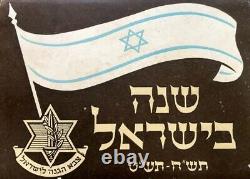
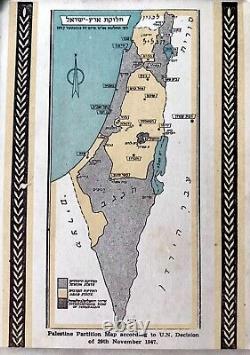

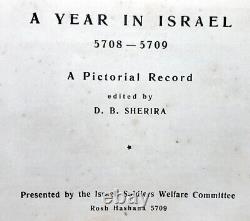
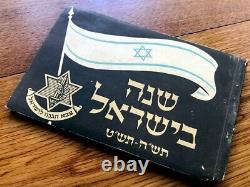

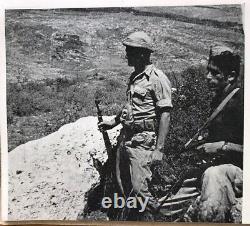
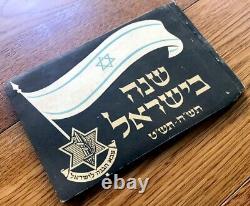
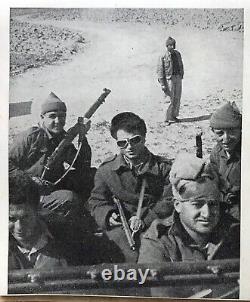
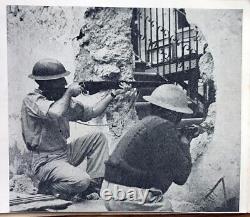
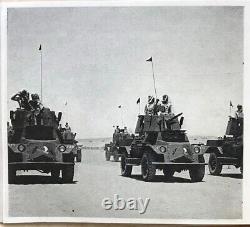
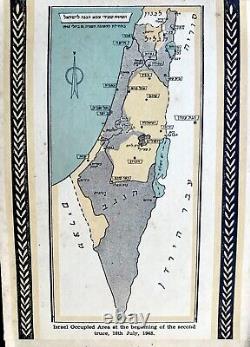
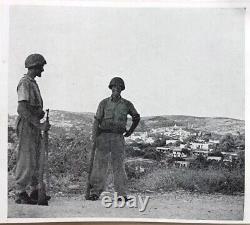
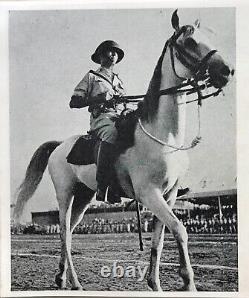
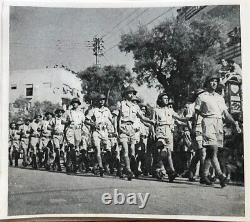
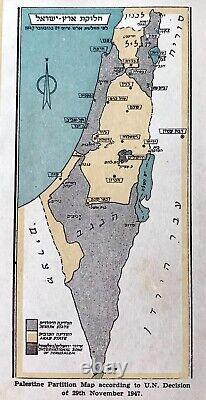
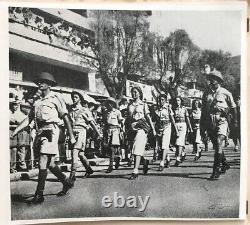
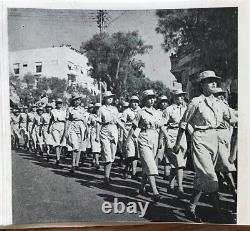
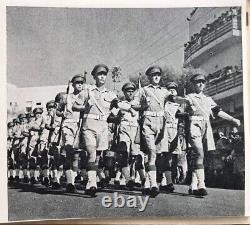
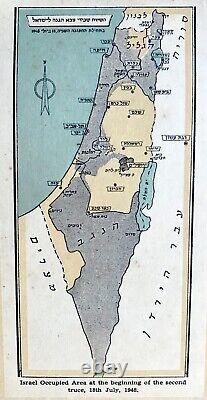
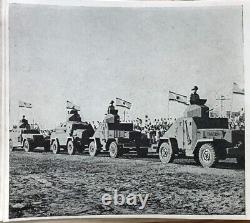
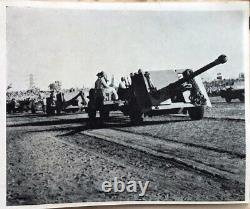
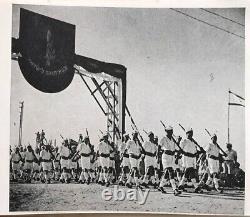
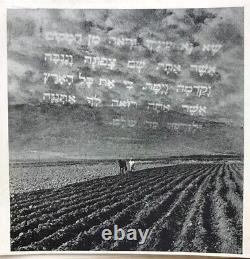


Here for sale is an AMAZING BEAUTY. It's a PHOTOGRAPHED SOUVENIR BOOK - Wonderfuly designed, Richly photographed and illustrated, Which was published in 1949, One year after the Jewish State was born, One year after the WAR of INDEPENDENCE, To commemorate and celebrate The STATE of ISRAEL first anniversary - A year of INDEPENDENCE. The book was published by the Israeli Soldiers Welfare Committee (IDF - ZAHAL). It is named A YEAR IN ISRAEL.
1948 - 1949 - A PICTORIAL RECORD. Written (Headings and short explanations to the photos) in HEBREW, ENGLISH and YIDDISH. Around 60 thrilling PHOTOS depicting the most exciting events of that year, Mainly ZAHAL and its WAR, But also ALIYA, Country rebuilt etc. 2 colored MAPS - One being the.
" PALESTINE PARTITION MAP ACCORDING TO UN DECISION of 29th NOVEMBER 1947" and the second map is ISRAEL OCCUPIED AREA at the BEGINING of the SECOND TRUCE, 18th JULY 1948. Size 7" x 4.5". Around 80 pp throughout photographed and illustrated. (Pls watch the scan for a reliable actual AS IS image). Booklet will be sent in a special protective rigid sealed package.
This booklet is guaranteed ORIGINAL from 1949, NOT a reprint or a recent edition , It comes with life long GUARANTEE for its AUTHENTICITY and ORIGINALITY. Book will be sent inside a protective packaging. The 1948 Israeli WAR OF INDEPENDENCE, known by the Israelis predominantly as War of Independence????? , was the first in a series of wars fought between the newly declared State of Israel and its Arab neighbors in the long-running Arab-Israeli conflict. The War was fought mostly on the territory of the British Mandate of Palestine, and for a short time also on the Sinai Peninsula. While the 1948 war was concluded with the 1949 Armistice Agreements it has not marked the end of the Arab-Israeli conflict. Following the defeat of the Ottoman Empire in World War I, the Allied Supreme Council met at the Villa Dechavan in San Remo, Italy, 18 April-26 1920 to settle the final terms of the peace treaty with Turkey.The decisions of the conference mainly confirmed those of the First Conference of London (February 1920), and broadly reaffirmed the terms of the Anglo-French Sykes-Picot Agreement of 16 May 1916 for the region's partition and the Balfour Declaration of 2 November 1917. The San Remo Agreement stated that'the mandatories chosen by the Principal Allied Powers are: France for Syria and Great Britain for Mesopotamia and Palestine. The high contracting parties agreed further that the territorial boundaries of these regions would be'determined by the Principal Allied Powers'. In the case of Palestine the borders were agreed between the British and French in two separate conventions: the Franco-British Convention of 23rd December 1920 on Certain Points Connected with the Mandates for Syria and the Lebanon, Palestine and Mesopotamia and the Agreement Between the British and the French Governments Respecting the Boundary Line Between Syria and Palestine from the Mediterranean to El Hammé, 1923. During meetings in Cairo and Jerusalem between Winston Churchill and Emir Abdullah in March 1921 it was agreed that Abdullah would administer the territory of Transjordan (initially for six months only) on behalf of the Palestine administration.
In the summer of 1921 Transjordan was included within the Mandate of Palestine, but excluded from the provisions for a Jewish National Home. On 24 July 1922 the League of Nations approved the terms of the British Mandate over Palestine and Transjordan. However, this area gradually saw a large influx of Jewish immigrants (most of whom were fleeing the increasing persecution in Europe). This immigration and accompanying call for a Jewish state in Palestine drew violent opposition from local Arabs, in part because of Zionism's stated goal of a Jewish state, which many Arabs believed would require the subjugation or removal of the existing non-Jewish population.
Under the leadership of Haj Amin al-Husayni, the Grand Mufti of Jerusalem, the local Arabs rebelled against the British, and attacked the growing Jewish population repeatedly. These sporadic attacks began with the riots in Palestine of 1920 and Jaffa riots (or "Hurani Riots") of 1921. During the 1929 Palestine riots (Pogroms), 133 Jews were killed, 67 of them in Hebron, and 355 wounded.By the time the British intervened 116 Arabs were also killed in the fighting. There was also support for the growth in influence of the radical nationalist Independence Party (Hizb al-Istiqlal), Indian Congress Party. Most of these initiatives were contained and defeated by notables in the pay of the Mandatory Administration, particularly the mufti and his cousin Jamal al-Husayni. The death of the preacher Shaykh Izz ad-Din al-Qassam at the hands of the British police near Jenin in November 1935 generated widespread outrage and huge crowds accompanied Qassam's body to his grave in Haifa. A few months later a spontaneous Arab national general strike broke out.
This lasted until October 1936. Over the next 18 months the British lost control of Jerusalem, Nablus, and Hebron. This resulted in the deaths of 5,000 Palestinian Arabs and the wounding of 10,000. In total 10 percent of the adult male population was killed, wounded, imprisoned, or exiled (see Khalidi, 2001).The Jewish population had 400 killed; the British 200. In another significant development during this time the British officer Charles Orde Wingate (who supported a Zionist revival for religious reasons) organized Special Night Squads composed of British soldiers and Haganah mercenaries, which "scored significant successes against the Arab rebels in the lower Galilee and in the Jezreel valley" by conducting raids on Arab villages. The squads were rumored to have used excessive and indiscriminate force, which has been cited by Israeli academic Anita Shapira. The Haganah mobilized up to 20,000 policemen, field troops and night squads; the latter included Yigal Allon and Moshe Dayan. Indeed, it might be argued that they were virtually without any leadership at all.
The attacks on the Jewish population by Arabs had three lasting effects: First, they led to the further development of Jewish underground militias, primarily the Haganah ("The Defense"), which were to prove decisive in 1948. Secondly, the attacks solidified general sentiment that the two communities could not be reconciled, and the idea of partition was born. Thirdly, the British responded to Arab opposition with the White Paper of 1939, which severely restricted Jewish immigration.
However, with the advent of World War II, even this reduced immigration quota was not reached. The White Paper policy also radicalized segments of the Jewish population, who after the war would no longer cooperate with the British. The British Mandate administration and training of local Arabs and JewsFrom 1936 onward the British government facilitated the training, arming, recruitment and funding of a range of security and intelligence forces in collaboration with the Jewish Agency. These included the Guards (Notrim), which were divided into the 6,000 to 14,000-strong Jewish Supernumerary Police, the élite and highly mobile 6,000-8,000 strong Jewish Settlement Police and the Special Night Squads, the forerunner of Britain's Special Air Service regiments. There was also an élite strike force known as the FOSH, or Field Companies, with around 1,500 members, which were replaced by the larger HISH or Field Force in 1939.
The SHAI, the intelligence and counter-espionage arm of the Haganah, was the forebear of Mossad. The British had enlisted 6,000 Palestinian Arabs during World War II and 1,700 Palestinian Arabs were recruited into the Trans-Jordanian Frontier Force or T.
In addition the British supplied officers, such as John Bagot Glubb Pasha for the Jordan's Arab Legion, and supplied the Egyptian army with trucks, rifles and airplanes. The British army therefore was intimately involved, ironically, in the training of both sides for the coming conflict. World War IIOn 6 August 1940 Anthony Eden, the British Secretary of State for War, informed Parliament that the Cabinet had decided to recruit Arab and Jewish units as battalions of the Royal East Kent Regiment (the "Buffs"). At a luncheon with Chaim Weizmann on 3 September Winston Churchill approved the large-scale recruitment of Jewish forces in Palestine and the training of their officers.
A further 10,000 men (no more than 3,000 from Palestine) were to be recruited to Jewish units in the British Army for training in the United Kingdom. Faced with Field Marshal Rommel's advance in Egypt, the British government decided on 15 April 1941 that the 10,000 Jews dispersed in the single defense companies of the Buffs should be prepared for war service at the battalion level and that another 10,000 should also be mobilized along with 6,000 Supernumerary Police and 40,000 to 50,000 home guard. The plans were approved by Field Marshall John Dill. The Special Operations Executive (SOE) in Cairo approved a Haganah proposal for guerrilla activities in northern Palestine led by the Palmach arm of the Haganah, as part of which Yitzhak Sadeh devised Plan North for an armed enclave in the Carmel range from which the Yishuv could defend the region and from which they could attack Nazi communications and supply lines, if necessary.British intelligence also trained a small radio network under Moshe Dayan to act as spy cells in the event of a German invasion. After much hesitation, on 3 July 1944 the British government consented to the establishment of a Jewish Brigade with hand-picked Jewish and also non-Jewish senior officers.
On 20 September 1944 an official communiqué by the War Office announced the formation of the Jewish Brigade Group of the British Army. The Zionist flag was officially approved as its standard. Arms were confiscated and some Haganah members were arrested and tried, one notable case being that of Eliahu Sacharoff, who received a sentence of seven years' imprisonment for possession of two stolen firearms cartridges. UN Partition Plan On 29 November 1947 the United Nations General Assembly approved a plan, UN General Assembly Resolution 181, to resolve the Arab-Jewish conflict by partitioning Palestine into two states, one Jewish and one Arab.
Each state would comprise three major sections, linked by extraterritorial crossroads; the Arab state would also have an enclave at Jaffa. With about 32% of the population, the Jews would get 56% of the territory, an area that then contained 499,000 Jews and 438,000 Palestinians, though this included the inhospitable Negev Desert in the south. The Palestinians would get 42% of the land, which then had a population of 818,000 Palestinians and 10,000 Jews.
In consideration of its religious significance, the Jerusalem area, including Bethlehem, with 100,000 Jews and an equal number of Palestinians, was to become a Corpus Separatum, to be administered by the UN. Although some Jews criticized aspects of the plan, the resolution was welcomed by most of the Jewish population. The Jewish leadership accepted the partition plan as "the indispensable minimum, " glad as they were with the international recognition, but sorry that they didn't get more.
Arguing that the partition plan was unfair to the Arabs with regard to the population balance at that time, the representatives of the Palestinian Arabs and the Arab League firmly opposed the UN action and even rejected its authority to involve itself in the entire matter. They upheld that the rule of Palestine should revert to its inhabitants, in accordance with the provisions of...
The Charter of the United Nations. According to Article 73b of the Charter, the UN should develop self-government of the peoples in a territory under its administration. Soon thereafter, violence broke out and became more prevalent.
Murders, reprisals, and counter-reprisals came one after the other, killing dozens of victims on both sides in the process. Summarizing the military assessments of the British, Jewish Agency and the Arabs, historian Benny Morris writes, all observers-Jewish, British, Palestinian Arab, and external Arab-agreed on the eve of the war that the Palestinians were incapable of beating the Zionists or of withstanding Zionist assault. The Palestinians were simply too weak. During the period beginning in December 1947 and ending in January 1948, it was estimated that nearly 1,000 people were killed and 2,000 people were injured. By the end of March, the figure had risen to 2,000 dead and 4,000 wounded.
These figures correspond to an average of more than 100 deaths and 200 casualties per week; in a population of 2,000,000. From January onwards operations became more militaristic, with the intervention into Palestine of a number of Arab Liberation Army regiments who divided up around the different coastal towns and reinforced Galilee and Samaria. Abd al-Qadir al-Husayni came from Egypt with several hundred men of the Army of Holy War. Having recruited a few thousand volunteers, al-Husayni organized the blockade of the 100,000 Jewish residents of Jerusalem. To counter this, the Yishuv authorities tried to supply the city with convoys of up to 100 armoured vehicles, but the operation became more and more impractical and more and more died in this process.By March, Al-Hussayni's tactic had paid off. Almost the entirety of Haganah's armoured vehicles had been destroyed, the blockade was in full operation, and hundreds of the Haganah members who tried to bring supplies to the city were killed. The situation for those who dwelt in the Jewish settlements in the highly-isolated Negev and northern Galilee was even more critical. Since the Jewish population was under strict orders obliging them to hold their dominions at all costs, the situation of insecurity across the country affected the Arab population more visibly.
Up to 100,000 Palestinians, chiefly those from the upper classes, left the country to seek refuge abroad or in Samaria. This situation caused the U. To retract their support for the Partition plan, thus encouraging the Arab League to believe that the Palestinians, reinforced by the Arab Liberation Army, could put an end to the partition plan.
The British, on the other hand, decided on 7 February 1948 to support the annexation of the Arab part of Palestine by Jordan. Although a certain level of doubt took hold amongst Yishuv supporters, their apparent defeats were due more to their wait-and-see policy than to weakness. Ben-Gurion reorganized the Haganah and made conscription obligatory. Every Jewish man and woman in the country had to receive military training. Due to funds gathered by Golda Meir from sympathizers in the United States, and assisted by Stalin's support for the Zionist cause at the time, the Jewish representatives of Palestine were able to sign very important armament contracts in the East.Other Haganah agents retrieved stockpiles from World War II, which helped equip the army further. Operation Balak allowed arms and other equipment to be transported for the first time by the end of March. Ben-Gurion assigned Yigael Yadin the responsibility to come up with a plan in preparation for the announced intervention of the Arab states.
The result of his analysis was Plan Dalet, which was put in place from the start of April onwards. The adoption of Plan Dalet marked the second stage of the war, in which Haganah passed from the defensive to the offensive.The first operation, named Operation Nachshon, consisted of lifting the blockade on Jerusalem. Fifteen hundred men from the Haganah's Givati Brigade and the Palmach's Harel brigade went about freeing the route to the city between 5 April and 20 April. The success of the operation was added to by the death of al-Hussayni in combat. Within the framework for the expansion of Jewish territory foreseen by Plan Dalet, the forces of Haganah, Palmach and Irgun intended to conquer mixed zones.
Whether ethnic cleansing was the intention, encouraged, or merely accepted, Palestinian society was shaken. Tiberias, Haifa, Safed, Beisan, Jaffa and Acre fell, resulting in the flight of more than 250,000 Palestinians. The British had, at that time, essentially withdrawn their troops. The situation pushed the leaders of the neighbouring Arab states to intervene, but their preparation was not finalized, and they could not assemble forces that would be able to turn the tide of the war. The majority of Palestinian hopes lay with the Arab Legion of Jordan's monarch, King Abdullah I, but he had no intention of creating a Palestinian-run state, instead hoping to annex as much of the territory of the British Mandate of Palestine as he could.Golda Meir and Abdullah I met on 10 May to discuss the situation, but the meeting was inconclusive and their former agreements were not confirmed. On 13 May, the Arab Legion, backed by irregulars, attacked and took Kfar Etzion where 127 out of the 131 Jewish defenders were killed and the prisoners massacred. On 14 May 1948, David Ben-Gurion declared the independence of the state of Israel, and the 1948 Palestine war entered its second phase, with the intervention of several Arab states' armies the following day.
Political objectivesThe YishuvBenny Morris points out Yishuv s aims evolved during the war. Initially, the aim was "simple and modest":to survive the assaults of the Palestinian Arabs and the Arab states.
"The Zionist leaders deeply, genuinely, feared a Middle Eastern reenactment of the Holocaust, which had just ended; the Arabs' public rhetoric reinforced these fears". As the war progressed, the aim of expanding the Jewish state beyond the UN partition borders appeared: first to incorporate clusters of isolated Jewish settlements and later to add more territories to the state and give it defensible borders.
A third and further aim that emerged among the political and military leaders after four or five months was to reduce the size of Israel's prospective large and hostile Arab minority, seen as a potential powerful fifth column, by belligerency and expulsion. "Morris has argued that although, by the end of 1947, the Palestinians "had a healthy and demoralising respect for the Yishuv's military power" they believed in decades or centuries "that the Jews, like the medieval crusader kingdoms, would ultimately be overcome by the Arab world. On the eve of the war the number of Arab troops likely to be committed to the war was about 23,000 (10,000 Egyptians, 4,500 Jordanians, 3,000 Iraqis, 3,000 Syrians, 2,000 ALA volunteers, 1,000 Lebanese and some Saudi Arabians), in addition to the irregular Palestinians already present. The Yishuv had 35,000 troops of the Haganah, 3,000 of Stern and Irgun and a few thousand armed settlers. On 12 May David Ben-Gurion was told by his chief military advisers,'who over-estimated the size of the Arab armies and the numbers and efficiency of the troops who would be committed', that Israel's chances of winning a war against the Arab states was only about even. Yishuv forcesIn November 1947, the Haganah was an underground paramilitary force that had existed as a highly organised, national force since the riots of 1920-21, and throughout the riots of 1929, and Great Uprising of 1936-39 It had a mobile force, the HISH, which had 2,000 full time fighters (men and women) and 10,000 reservists (all aged between 18 and 25) and an elite unit, the Palmach composed of 2,100 fighters and 1,000 reservists. The reservists trained 3-4 days a month and went back to civilian life the rest of the time. These mobile forces could rely on a garrison force, the HIM Heil Mishmar, lit. Guard Corps, composed of people aged over 25. The Yishuv's total strength was around 35,000 with 15,000 to 18,000 fighters and a garrison force of roughly 20,000 The two clandestine groups Irgun and Lehi had 2,000-4,000 and 500-800 members, respectively. There were also several thousand men and women who had served in the British Army in World War II who did not serve in any of the underground militias but would provide valuable military experience during the war.Walid Khalidi says the Yishuv had the additional forces of the Jewish Settlement Police, numbering some 12,000, the Gadna Youth Battalions, and the armed settlers. By September 1947 the Haganah had "10,489 rifles, 702 light machine-guns, 2,666 submachine guns, 186 medium machine-guns, 672 two-inch mortars and 92 three-inch (76 mm) mortars" and acquired many more during the first few months of hostilities. The Yishuv also had "a relatively advanced arms producing capacity", that between October 1947 and July 1948 "produced 3 million 9 mm bullets, 150,000 mills grenades, 16,000 submachine guns (Sten Guns) and 210 three-inch (76 mm) mortars". Initially, the Haganah had no heavy machine guns, artillery, armoured vehicles, anti-tank or anti-aircraft weapons, nor military aircraft or tanks.
Sources disagree about the amount of arms at the Yishuv's disposal at the end of the Mandate. According to Collins and LaPierre, by April 1948 the Haganah had managed to accumulate only about 20,000 rifles and Sten guns for the 35,000 soldiers who existed on paper. According to Walid Khalidi "the arms at the disposal of these forces were plentiful". 1948 Arab-Israeli War First phase: 14 May 1948-11 June 1948 The British mandate over Palestine was due to expire on 15 May, but Jewish Leadership led by future Prime Minister, David Ben-Gurion, declared independence on 14 May. The State of Israel declared itself as an independent nation, and was quickly recognized by the United States, the Soviet Union, and many other countries. Over the next few days, approximately 1,000 Lebanese, 5,000 Syrian, 5,000 Iraqi, and 10,000 Egyptian troops invaded the newly-established state.Four thousand Jordanian troops invaded the Corpus separatum region encompassing Jerusalem and its environs, as well as areas designated as part of the Arab state by the UN partition plan. They claimed the latter was invalid, as it was opposed by Palestine's Arab majority, and maintained that the absence of legal authority made it necessary to intervene to protect Arab lives and property.
Israel, the United States and the Soviets called the Arab states' entry into Palestine illegal aggression, while UN Secretary-General Trygve Lie characterized it as the first armed aggression which the world had seen since the end of the [Second World] War. China, meanwhile, broadly backed the Arab claims. Both sides increased their manpower over the following months, but the Israeli advantage grew steadily as a result of the progressive mobilization of Israeli society and the influx of an average of 10,300 immigrants each month.On 26 May 1948, the Israel Defense Forces (IDF) was officially established and the Haganah, Palmach and Irgun were dissolved into the army of the new Jewish state. As the war progressed, the IDF managed to field more troops than the Arab forces. By July 1948, the IDF was fielding 63,000 troops; by early spring 1949, 115,000.
The Arab armies had an estimated 40,000 troops in July 1948, rising to 55,000 in October 1948, and slightly more by the spring of 1949. All Jewish aviation assets were placed under the control of the Sherut Avir (Air Service, known as the SA) in November 1947 and flying operations began in the following month from a small civil airport on the outskirts of Tel Aviv called Sde Dov, with the first ground support operation in an R. 13 taking place on 17 December. By 10 May, when the SA suffered its first combat loss, there were three flying units, an air staff, maintenance facilities and logistics support. At the outbreak of the war on 15 May the SA became the Israeli Air Force, but, during the first few weeks of the war, with its fleet of light planes it was no match for Arab forces flying T-6s, Spitfires, C-47s and Avro Ansons and indeed the main Arab losses were the result of RAF action in response to Egyptian raids on the British air base at Ramat David near Haifa on 22 May during which 5 Egyptian Spitfires were shot down.
This created the ironic situation of the young Jewish state using derivatives of the Bf-109 designed in Nazi Germany to help counter the British-designed Spitfires flown by Egypt. The first raid on an Arab capital followed on the night of 31 May/June 1 when three Israeli planes bombed Amman. By the fall of 1948, The IDF achieved air superiority and had superiority in firepower and knowledgeable personnel, many of whom had seen action in World War II. The first mission of the IDF was to hold on against the Arab armies and stop them from destroying major Jewish settlements, until reinforcements and weapons arrived. The heaviest fighting would occur in Jerusalem and on the Jerusalem-Tel Aviv road, between Jordan's Arab Legion and the Israeli forces. Abdullah ordered Glubb Pasha, the commander of the Jordanian-led Arab Legion, to enter Jerusalem on 17 May, and heavy house-to-house fighting occurred between 19 May and 28 May, with the Arab Legion succeeding in expelling Israeli forces from the Arab quarters of Jerusalem as well as the Jewish Quarter of the Old City. All the Jewish inhabitants of the Old City were expelled by the Jordanians. Iraqi troops failed in attacks on Jewish settlements (the most notable battle was on Mishmar HaEmek), and instead took defensive positions around Jenin, Nablus, and Tulkarm. On 24 May 1948 IDF forces at Latrun-consisting of the 7th Armoured Brigade (Israel) and the Alexandroni Brigade-attacked the Arab Legion forces in Operation "Bin-Nun A" and on 1 June 1948 the same IDF forces again attacked Latrun Arab Legion forces in Operation "Bin-Nun B". One tank that was disabled by a Molotov cocktail is still present at the kibbutz. Later, an artillery bombardment, made by cannons jury-rigged from 19th century museum pieces, led to the withdrawal of the Syrians from the kibbutz. This attack was stopped near Ashdod. The Israeli military managed not only to maintain their military control of the Jewish territories, but to expand their holdings. First truce 11 June 1948-8 July 1948 The UN declared a truce on 29 May which came into effect on 11 June and would last 28 days. The cease-fire was overseen by the UN mediator Folke Bernadotte. An arms embargo was declared with the intention that neither side would make any gains from the truce. At the end of the truce, Folke Bernadotte presented a new partition plan that would give the Galilee to the Jews and the Negev to the Arabs. Both sides rejected the plan. On 8 July, before the expiration of the truce, Egyptian General Naguib renewed the war by attacking the Negba position of Israel. Second phase (8 July 1948-18 July 1948)The ten days at the height of the summer between the two truces were dominated by large scale Israeli offensives and a defensive posture from the Arab side. Operation Dani was the most important Israeli offensive, aimed at securing and enlarging the corridor between Jerusalem and Tel Aviv by capturing the roadside cities Lydda (later renamed Lod) and Ramle. The second plan was Operation Dekel whose aim was to capture the lower Galilee including Nazareth. The third plan, to which fewer resources were allocated, Operation Kedem was to secure the Old City of Jerusalem. Operation DaniLydda Lod was mainly defended by the Jordan Army, but also local Palestinian militias and the Arab Liberation Army were present. The city was attacked from the north via Majdal al-Sadiq and al-Muzayri'a and from the east via Khulda, al-Qubab, Jimzu and Danyal. Bombers were also used for the first time in the conflict to bombard the city.On 11 July 1948 the IDF captured the city. The next day, 12 July 1948 Ramle also fell to the hands of Israel. 15 July-July 16 an attack on Latrun took place but did not manage to occupy the fort. A desperate second attempt occurred (18 July) by units from the Yiftach Brigade equipped with armored vehicles, including two Cromwell tanks, but that attack also failed.
Despite the second truce, which began on 18 July, the Israeli efforts to conquer Latrun continued until 20 July. Operation DekelWhile Operation Dani proceeded in the centre, Operation Dekel was carried out in the north. Nazareth was captured on 16 July and when the second truce took effect at 19:00 18 July, the whole lower Galilee from Haifa bay to the Sea of Galilee was captured by Israel. Operation KedemOriginally the operation was to be executed on 8 July, immediately after the first truce, by Irgun and Lehi. However, it was delayed by David Shaltiel, possibly because he did not trust their ability after their failure to capture Deir Yassin without Haganah assistance.The Irgun forces that were commanded by Yehuda Lapidot (Nimrod) were to break through at The New Gate, Lehi was to break through the wall stretching from the New Gate to the Jaffa Gate and the Beit Hiron Battalion was to strike from Mount Zion. The battle was planned to begin on the Sabbath, at 20:00 Friday 16 July a day before the Second Cease-fire of the Arab-Israeli war. The plan went wrong from the beginning and was postponed first to 23:00 and then to midnight. It was not until 02:30 that the battle actually began.
The Irgunists managed to break through at the New Gate but the other forces failed in their missions. At 05:45 in the morning Shaltiel ordered a retreat and to cease the hostilities. Second truce: 18 July 1948-15 October 194819:00 18 July, the second truce of the conflict went into effect after intense diplomatic efforts by the UN.
On 16 September, Folke Bernadotte proposed a new partition for Palestine in which Jordan would annex Arab areas including the Negev, al-Ramla, and Lydda. There would be a Jewish state in the whole of Galilee, internationalization of Jerusalem, and return or compensation for refugees. The plan was once again rejected by both sides.
On the next day, 17 September, Bernadotte was assassinated by the Lehi and his deputy, American Ralph Bunche, replaced him. Third phase (15 October 1948-20 July 1949)Israeli operationsBetween 15 October and 20 July Israel launched a series of military operations in order to drive out the Arab armies and secure the borders of Israel.
On 24 October, the IDF launched Operation Hiram and captured the entire Upper Galilee, driving the ALA and Lebanese army back to Lebanon. It was a complete success and at the end of the month, Israel had not only managed to capture the whole Galilee but had also advanced 5 miles (8.0 km) into Lebanon to the Litani River.
On 15 October the IDF launched Operation Yoav in the northern Negev. Its goal was to drive a wedge between the Egyptian forces along the coast and the Beersheba-Hebron-Jerusalem road and ultimately to conquer the whole Negev. Operation Yoav was headed by the Southern Front commander Yigal Allon. The operation was a huge success as it shattered the Egyptian army ranks and forced the Egyptian forces to retreat from the northern Negev, Beersheba and Ashdod.
On 22 October the Israeli Navy commandoes sank the Egyptian flagship Amir Faruk. On 22 December the IDF drove the remaining Egyptian forces out of Israel, by launching Operation Horev (also called Operation Ayin). The goal of the operation was to secure the entire Negev from Egyptian presence, destroying the Egyptian threat on Israel's southern communities and forcing the Egyptians into a cease-fire. The operation was a decisive Israeli victory, and Israeli raids into the Nitzana and the Sinai peninsula forced the Egyptian army, which was encircled in the Gaza Strip, to withdraw and accept cease-fire.On 7 January a truce was achieved. Israeli forces withdrew from Sinai and Gaza under international pressure.
On 5 March Operation Uvda was launched. On 10 March the Israelis reached Umm Rashrash (where Eilat was built later) and conquered it without a battle. The Negev Brigade and Golani Brigade took part in the operation. They raised a hand-made flag ("The Ink Flag") and claimed Umm Rashrash for Israel. UN Resolution 194 In December 1948, the UN General Assembly passed Resolution 194 which declared (amongst other things) that in the context of a general peace agreement "refugees wishing to return to their homes and live in peace with their neighbors should be permitted to do so" and that compensation should be paid for the property of those choosing not to return.The resolution also mandated the creation of the United Nations Conciliation Commission. However, parts of the resolution were never implemented, resulting in the Palestinian refugee crisis.
The Israeli Declaration of Independence Hebrew:????? Hakhrazat HaAtzma'ut or Hebrew:????? Independence Day, the timing of which is based on the Hebrew calendar date of the declaration (5, Iyar, 5708). Palestinias commemorate the event as Nakba Day Arabic:???
Catastrophe Day on 15 May every year. The General Assembly of the United Nations had resolved that'No discrimination of any kind shall be made between the inhabitants on the ground of race, religion, language or sex. And that a declaration to that effect would be made to the United Nations by the Provisional Government of each proposed State before independence.The General Assembly resolution mandated that the stipulations contained in the Declaration were to be non-derogable, they were to be'recognized as fundamental laws of the State and no law, regulation or official action shall conflict or interfere with these stipulations, nor shall any law, regulation or official action prevail over them. The Declaration did promise that the State of Israel would ensure complete equality of social and political rights to all its inhabitants irrespective of religion, race or sex, and guaranteed freedom of religion, conscience, language, education and culture.
However, the Knesset maintains that declaration is neither a law nor an ordinary legal document. The Supreme Court of Israel has ruled that the guarantees were merely guiding principles, and that the Declaration is not a constitutional law making a practical ruling on the upholding or nullification of various ordinances and statutes. Whenever an explicit statutory measure of the Knesset leaves no room for doubt, it is honored even if inconsistent with the principles in the Declaration of Independence. While the possibility of a Jewish homeland in Palestine had been a goal of Zionist organisations since the late 19th century, it was not until 1917 and the Balfour declaration that the idea gained the official backing of a major power.The declaration stated that the British government supported the creation of a national home for the Jewish people in Palestine. The result was Resolution 181, a partition plan to divide Palestine between Jews and Arabs. The Jewish state was to receive around 56% of the land area of Mandate Palestine, encompassing 82% of the Jewish population, though it would be separated from Jerusalem, designated as an area to be administered by the UN. The plan was accepted by most of the Jewish population, but rejected by much of the Arab populace. On 29 November 1947, the plan was put to a vote in the United Nations General Assembly The result was 33 to 13 in favour of the plan, with 10 abstentions.
The Arab countries (all of which had opposed the plan) proposed to query the International Court of Justice on the competence of the General Assembly to partition a country against the wishes of the majority of its inhabitants, but were again defeated. The division was to take effect on the date of British withdrawal from the territory (15 May 1948), though the UK refused to implement the plan, arguing it was unacceptable to both sides. The Israel Defense Forces (IDF) Hebrew:????? Tzva HaHagana LeYisra'el (help·info), lit.Defense Army for Israel, commonly known in Israel by the Hebrew acronym Tzahal?? , are Israel's military forces, comprising the ground forces, air force and navy.
It is the sole military wing of the Israeli security forces, and has no civilian jurisdiction within Israel. The IDF is headed by its Chief of General Staff, the Ramatkal, subordinate to the Defense Minister of Israel; the current Chief of Staff, since 2007, is Lieutenant General Gabi Ashkenazi. At the order of Defense Minister David Ben-Gurion on May 26, 1948, the Israel Defense Forces were officially formed as a conscript army out of the paramilitary group Haganah, incorporating the militant groups Irgun and Lehi.
It served as Israel's armed forces in all the country's major military operations - including the 1948 Arab-Israeli War, the 1956 Sinai War, the 1967 Six-Day War, the War of Attrition, the 1973 Yom Kippur War, Operation Litani, the 1982 Lebanon War, Operation Defensive Wall, the 2006 Lebanon War and Operation Cast Lead. While originally the IDF was operational on three fronts-against Lebanon and Syria in the north, Jordan and Iraq in the east, and Egypt in the south-after the 1979 Egyptian-Israeli Peace Treaty, its activities have mainly been concentrated in southern Lebanon and the Palestinian Territories, including the First and the Second Intifada. The Israel Defense Forces differs from most armed forces in the world in many ways, including the conscription of women, and the structure, with close relations between the ground forces, air force and navy.Since its founding, the IDF has striven to be a unique army fitting Israel's specific requirements. In 1965, the Israel Defense Forces was awarded the Israel Prize for its contribution to education. The IDF uses several technologies developed in Israel, many of them made specifically to match the IDF's needs, such as the Merkava main battle tank, advanced Hi-Tech weapons systems, and the Galil and Tavor assault rifles. The Uzi submachine gun was used by the IDF until December 2003, ending a service that began in 1954. The IDF also has close military relations with the United States, including development cooperation, such as on the F-15I jet, THEL laser defense system, and the Arrow missile defense system.
History Main articles: History of the Israel Defense Forces and Military operations conducted by the Israeli Defense Forces The IDF traces its roots to Jewish paramilitary organizations in the New Yishuv, starting with the Second Aliyah. The first such organization was Bar-Giora, founded in September 1907. It was converted to Hashomer in April 1909, which operated until the British Mandate of Palestine came into being in 1920.
Hashomer was an elitist organization with narrow scope, and was mainly created to protect against criminal gangs seeking to steal property. During World War I the forerunners of the Haganah/IDF were the Zion Mule Corps and the Jewish Legion. After the Arab riots against Jews in April 1920, the Yishuv's leadership saw the need to create a nationwide underground defense organization, and the Haganah was founded in June of the same year. During World War II the successor to the Jewish Legion of World War I was the Jewish Brigade. The IDF was founded following the establishment of the State of Israel, after Defense Minister and Prime Minister David Ben-Gurion published the order for its creation on May 26, 1948.
The order called for the establishment of the Israel Defense Forces, and the abolishment of all other Jewish armed forces. Although Ben-Gurion had no legal authority to issue such an order, the order was made legal by the cabinet on May 31. This was the background for the dispute which led to the Altalena Affair, when following a confrontation regarding the weapons it brought resulted in a battle between Irgun members the newly-created IDF. Following the affair, all independent Irgun and Lehi units were either disbanded or merged into the IDF. The Palmach, a strong lobby within the Haganah, also joined the IDF with provisions, and Ben Gurion responded by disbanding its staff in 1949, after which many senior Palmach officers retired, notably its first commander, Yitzhak Sadeh. The new army organized itself during the 1948 Arab-Israeli War, when Syria, Lebanon, Egypt, Transjordan, Iraq, Saudi Arabia and Yemen declared war on Israel. Twelve infantry and armored brigades were created: Golani, Carmeli, Alexandroni, Kiryati, Givati, Etzioni, the 7th and 8th armored brigades, Oded, Harel, Yiftach and Negev. After the war, some of the brigades were converted to reserve units, and others were disbanded. Directorates and corps were created from corps and services in the Haganah, and this basic structure in the IDF still exists today. Immediately after the 1948 war, the Israel Defense Forces shifted to low intensity conflict against Arab Palestinian guerrillas. In the 1967 Six-Day War, Israel captured the Sinai Peninsula, West Bank and Golan Heights from the surrounding Arab states, changing the balance of power in the region as well as the role of the IDF. In the following years leading up to the Yom Kippur War, the IDF fought a war of attrition against Egypt in the Sinai and a border war against the PLO in Jordan, culminating in the Battle of Karameh.The surprise of the Yom Kippur War and its aftermath completely changed the IDF's procedures and approach to warfare. Organizational changes were made and more time was dedicated to training for conventional warfare.
However, in the following years the army's role slowly shifted again to low-intensity conflict, urban warfare and counter-terrorism. It was involved in the Lebanese Civil War, initiating Operation Litani and later the 1982 Lebanon War, where the IDF ousted Palestinian guerilla organizations from Lebanon. Palestinian militancy has been the main focus of the IDF ever since, especially during the First and Second Intifadas, Operation Defensive Shield and the Gaza War, causing the IDF to change many of its values and publish the IDF Spirit. The Shia organization Hezbollah has also been a growing threat, against which the IDF fought a full-scale war in 2006.
Etymology The name Israel Defense Forces Hebrew:????? Tzva HaHagana LeYisra'el, literally "The Defense Army for Israel" was ratified by the Israeli cabinet on May 26, 1948, the day that the order for the army's founding was published by David Ben-Gurion. The main suggested alternative was Israeli Army/Army of Israel Hebrew:????? Tzva Yisra'el, while others included Jewish Army and Army of the State. The name was chosen for two reasons: because it emphasized that army's role was for defense only, and because it incorporated the name Haganah, the paramilitary organization it was based on. At least three people claim to have coined the name. The Defense Ministry CEO at the time, David Izre'eli, wrote that he suggested it to Levi Eshkol, who forwarded the suggestion to the cabinet. The Chief of Staff Ya'akov Dori, while not claiming to have personally coined the name, said that it was prevalent among senior army personnel and therefore the only natural name.Ben-Gurion was the third, quoted as saying I gave the name. The name was'Israel Defense Forces'. Among the primary opponents of the name were Minister Haim-Moshe Shapira and the Hatzohar party, both suggesting the name Israeli Army. Organization All branches of the IDF are subordinate to a single General Staff. The Chief of the General Staff is the only serving officer having the rank of Lieutenant General (Rav Aluf).
He reports directly to the Defense Minister and indirectly to the Prime Minister of Israel and the cabinet. Chiefs of Staff are formally appointed by the cabinet, based on the Defense Minister's recommendation, for three years, but the government can vote to extend their service to four (and in rare occasions even five) years. The current chief of staff is Gabi Ashkenazi. He replaced Dan Halutz, who resigned from the IDF following the 2006 Lebanon War.

